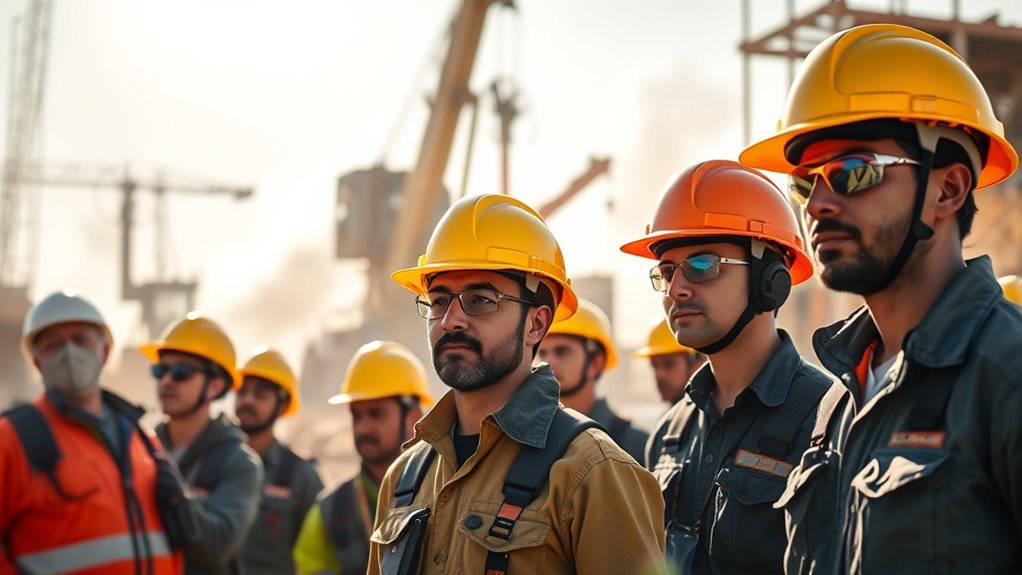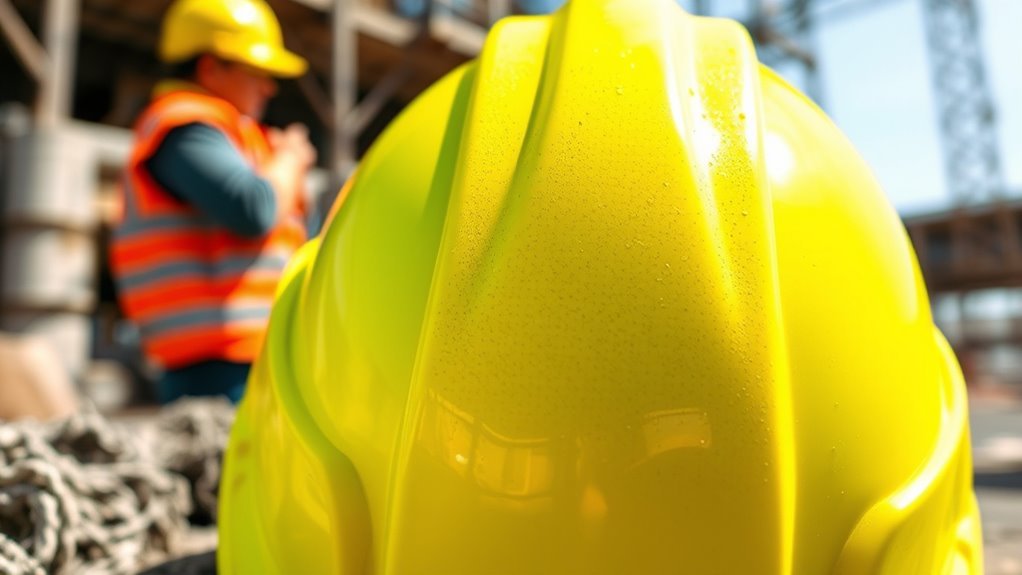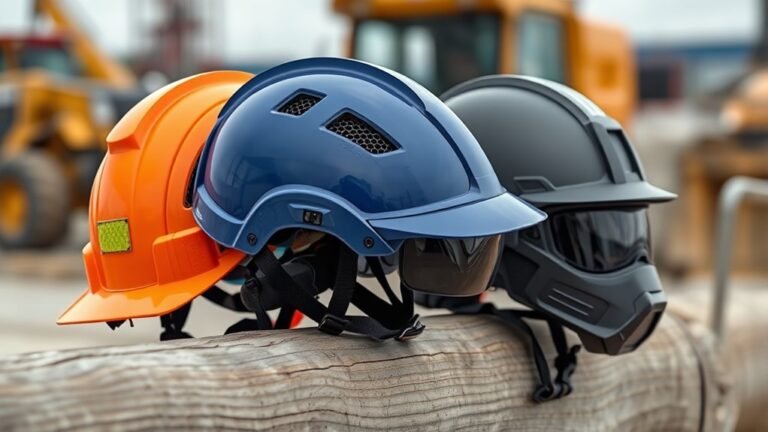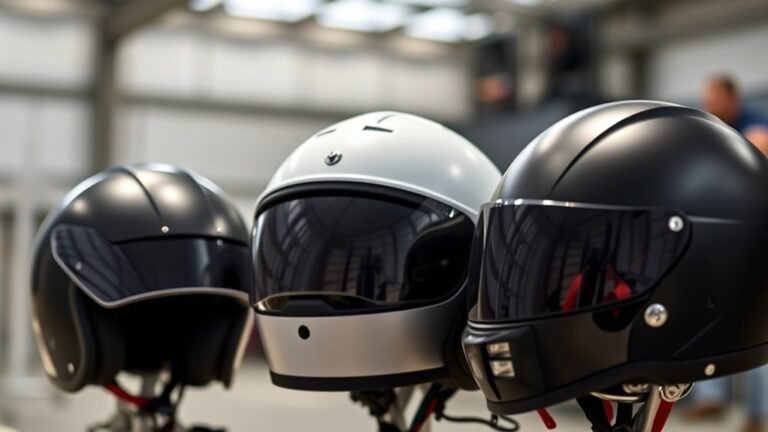High-Visibility Helmet Colors for Maximum Safety
High-visibility helmet colors are vital for maximizing safety in hazardous environments. Bright shades like neon yellow, orange, and green reflect more light, enhancing your visibility and reducing the chances of accidents. In contrast, low-visibility colors like blue may blend into backgrounds, decreasing safety. Adhering to industry regulations guarantees compliance with color standards. For the best impact, proper maintenance of your helmet’s color is indispensable. Discover more about the science behind color and safety gear.
The Importance of Helmet Color in High-Risk Environments

When you’re working in high-risk environments, the color of your helmet isn’t just a matter of preference; it plays an essential role in safety. Helmet color psychology suggests that certain colors can enhance visibility and improve recognition in various conditions. Bright colors like yellow, orange, and lime green are often favored for their high visibility, making it easier for others to spot you. Implementing visibility enhancement strategies, such as choosing a helmet color that contrasts with your surroundings, can greatly reduce the chances of accidents. Additionally, using reflective materials can further amplify your visibility, especially in low-light situations. By selecting the right helmet color, you’re not just expressing individuality; you’re prioritizing your safety and the safety of those around you.
Understanding High-Visibility Colors

Although many may underestimate the significance of color in safety gear, understanding high-visibility colors is essential for enhancing recognition in hazardous environments. High-visibility colors, such as neon yellow, orange, and green, are strategically chosen based on color theory principles that dictate their visibility impact. These colors reflect more light, making them easier to see in various conditions, including low light or bad weather. Conversely, certain colors like blue or red may not provide the same level of visibility and can blend into backgrounds. By selecting helmets in high-visibility shades, you increase your chances of being noticed, thereby reducing the risk of accidents. Ultimately, this understanding empowers you to make informed choices about your safety gear.
The Psychology of Color Recognition

Color recognition plays an essential role in how individuals perceive and respond to their environment, especially in safety contexts. Your ability to quickly identify colors hinges on color perception, which influences decision-making in critical situations. High-visibility colors, like neon yellow or orange, create significant visual contrast against various backgrounds, making it easier for you to spot hazards or other individuals. Research shows that bright colors can evoke alertness and awareness, enhancing your responsiveness. In dynamic environments, this psychological effect can mean the difference between safety and danger. By understanding the nuances of color recognition, you can better appreciate how specific helmet colors enhance visibility and support your need for freedom in maneuvering potentially hazardous situations.
Common Helmet Colors and Their Meanings
When selecting a helmet, it’s important to understand the standard color associations and their meanings. Different industries often employ specific color codes to convey information about roles and safety levels. By recognizing these colors, you can enhance your visibility and communicate your position effectively.
Standard Color Associations
Helmets come in various colors, each carrying specific meanings that enhance safety and visibility in different environments. Color symbolism plays an essential role; for instance, yellow helmets often signify caution and high visibility, making them popular in construction zones. Red helmets are typically associated with emergency responders, symbolizing urgency and alertness. Blue helmets can denote a management or supervisory role, while green helmets often indicate safety officers, emphasizing their authority in maintaining workplace safety. Cultural perceptions also influence these associations; for example, white helmets may represent neutrality in some regions but authority in others. Understanding these standard color associations can meaningfully improve communication and safety awareness in diverse environments.
Industry-Specific Color Codes
Understanding industry-specific color codes for helmets is essential for ensuring safety and effective communication on job sites. Different sectors utilize distinct color coding that aligns with industry standards, allowing workers to quickly identify roles and responsibilities. Here’s a quick reference table to help you recognize common helmet colors and their meanings:
| Helmet Color | Meaning |
|---|---|
| White | Site Supervisor |
| Yellow | General Labor |
| Blue | Technical Engineer |
| Green | Safety Officer |
Regulations and Standards for Safety Helmets
When selecting a safety helmet, you’re required to take into account both helmet color and compliance with established safety standards. Different industries have specific regulations regarding color visibility to guarantee maximum safety. Understanding these requirements is essential for maintaining safety protocols and meeting legal obligations.
Helmet Color Requirements
While safety helmets are essential for protecting workers in various environments, specific color requirements are often dictated by regulations and industry standards. These requirements guarantee maximum visibility and safety, reflecting current helmet color trends and findings from color visibility research. Here are three key points to take into account:
- Industry-Specific Colors: Different industries may mandate specific colors for helmets, such as yellow for construction or white for general use.
- Reflective Materials: Some regulations require the use of reflective materials to enhance visibility, especially in low-light conditions.
- Standard Compliance: Helmets must comply with standards set by organizations like ANSI or OSHA, which often include color specifications.
Understanding these requirements helps you choose the right helmet for safety and compliance.
Compliance With Safety Standards
Compliance with safety standards is a critical factor in selecting the appropriate helmet for a specific work environment. To guarantee you’re protected, it’s crucial to understand the relevant safety regulations applicable to your industry. These regulations outline the minimum performance requirements for helmets, including impact resistance and durability. Implementing compliance strategies is essential; this might involve regular training sessions on safety protocols and routine inspections of your gear. When you choose a helmet that meets recognized standards, you’re not just following the law—you’re prioritizing your safety and that of your colleagues. Remember, staying informed about updates in safety regulations can empower you to make better choices, guaranteeing you remain free to work confidently in any environment.
Factors Influencing Helmet Color Choice
Choosing the right helmet color involves several key factors that can enhance safety and visibility. Your choice impacts not only your personal style but also your safety on the road or job site.
- Color Psychology: Bright colors like fluorescent yellow or orange attract attention, reducing accident risk.
- Helmet Design Trends: Staying current with design trends can help guarantee your helmet isn’t just safe but also visually appealing.
- Environment: Consider the environments you’ll be in; for instance, a bright helmet stands out against a green landscape but may blend into urban settings.
Tips for Maintaining Helmet Visibility
How can you guarantee your helmet remains visible in various conditions? Start by selecting a helmet that incorporates bright colors and reflective materials. Regularly inspect your helmet for scuffs or fading; these can reduce visibility. To enhance visibility during low-light situations, consider using illumination techniques such as attaching LED lights or reflective stickers. Positioning these elements strategically guarantees they catch the light effectively. Additionally, maintaining the cleanliness of your helmet is essential; dirt can diminish the brightness of colors and reflective surfaces. Finally, store your helmet in a location away from direct sunlight to prevent color degradation over time. By following these tips, you’ll guarantee your helmet remains a beacon of safety, allowing you the freedom to ride with confidence.
How Weather Conditions Affect Helmet Visibility
Weather conditions greatly impact helmet visibility, which is vital for safety. In fog or low visibility scenarios, bright colors can become less effective, while rain and wet conditions can dull brightness and reflections. Snow and winter hazards further complicate visibility, emphasizing the need for appropriate helmet color choices in varying environments.
Fog and Low Visibility
Although fog can create a serene atmosphere, it considerably reduces visibility, making high-visibility helmet colors even more essential for safety. In foggy conditions, riders face significant visibility challenges that can lead to dangerous situations. To enhance your safety, consider the following:
- Choose Bright Colors: Opt for neon shades like yellow or orange that stand out even in low visibility.
- Add Reflective Materials: Incorporate reflective strips to boost visibility when light hits your helmet.
- Use Lights: Attach small LED lights to your helmet to increase your presence in foggy environments.
Rain and Wet Conditions
When it rains, visibility can plummet, making high-visibility helmet colors essential for safety. Wet conditions not only obscure your surroundings but also create reflections that can distort perception. This is why choosing the right helmet color is vital; it can mean the difference between being seen or overlooked.
| Helmet Color | Visibility in Rain | Recommended Use |
|---|---|---|
| Neon Yellow | High | Urban riding |
| Bright Orange | Moderate | Trail riding |
| White | Low | Off-road riding |
Snow and Winter Hazards
As snow blankets the landscape, visibility can drastically decrease, making the choice of helmet color even more critical for safety. During winter conditions, specific factors influence snow visibility and increase winter hazards.
Consider these essential tips:
- Choose Bright Colors: Opt for neon or fluorescent shades like yellow or orange, which stand out against the white backdrop.
- Reflective Elements: Helmets with reflective strips enhance visibility during low-light conditions, especially in snowy weather.
- Match Your Gear: Ascertain your helmet color contrasts with your clothing and surroundings to maximize visibility.
Case Studies: Helmet Color Impact on Safety
How important is the role of helmet color in enhancing safety? Numerous visibility case studies highlight the direct impact of helmet color effectiveness on accident prevention. For instance, bright colors like fluorescent yellow and orange greatly increase visibility in various environments, reducing the risk of mishaps.
Here’s a summary of some key findings:
| Helmet Color | Visibility Rating | Accident Reduction |
|---|---|---|
| Fluorescent Yellow | High | 30% |
| Neon Orange | High | 25% |
| White | Moderate | 15% |
| Black | Low | 5% |
| Bright Green | High | 20% |
These insights emphasize the importance of choosing the right helmet color for enhanced safety in any setting.
Future Trends in High-Visibility Safety Gear
With the growing emphasis on safety measures, the development of high-visibility safety gear is evolving rapidly. You’ll notice that future trends focus on integrating innovative materials and advanced reflective technologies to enhance visibility and comfort. Here are three key trends to watch:
- Smart Fabrics: These materials adapt to environmental changes, improving visibility in low-light conditions.
- Embedded LEDs: Incorporating LED lights into gear enhances visibility, especially in urban environments or during nighttime operations.
- Sustainable Materials: As eco-consciousness grows, expect more safety gear made from recycled and biodegradable materials, maintaining high visibility without harming the planet.
These advancements not only improve safety but also align with the freedom to express individual style while prioritizing protection.
Frequently Asked Questions
Can I Customize My Helmet Color for Better Visibility?
Absolutely, you can customize your helmet color for better visibility! Imagine a striking neon orange or vibrant lime green that catches the eye instantly. Custom color options not only reflect your personality but also provide visibility enhancements, making you stand out in any environment. Guarantee your choice meets safety regulations while considering reflective decals or patterns for added flair. With the right colors, you’re not just riding; you’re making a statement while staying safe.
Are There Specific Colors for Different Industries?
Yes, there are specific colors for different industries based on color coding and industry standards. For instance, construction often uses orange or yellow helmets for high visibility, while electrical workers might wear white to signify safety. These color codes help guarantee that workers can quickly identify roles and hazards on-site. It’s vital to follow these standards not just for compliance, but also to enhance safety and communication within your work environment.
How Often Should I Replace My Helmet for Safety?
You should replace your helmet every 3 to 5 years, depending on its condition and the manufacturer’s guidelines. Even if it looks fine, materials can degrade over time, compromising safety standards. Regularly inspect your helmet for signs of damage, such as cracks or dents, and replace it immediately if you notice any. Staying proactive about your helmet’s lifespan guarantees you’re protected while enjoying the freedom of your activities.
Do Reflective Stickers Impact Helmet Visibility?
Yes, reflective stickers can greatly enhance your helmet’s visibility. While some might argue that color is enough, incorporating reflective materials provides an extra layer of safety, especially in low-light conditions. These stickers reflect light, making you more noticeable to others. If you’re looking for freedom while riding or engaging in outdoor activities, improving your visibility with reflective stickers is a smart choice that shouldn’t be overlooked for your overall safety.
Can Helmet Color Affect Worker Morale or Compliance?
Yes, helmet color can greatly affect worker morale and compliance. Bright colors can enhance helmet aesthetics, making them more appealing and encouraging usage. Color psychology suggests that certain hues evoke specific emotions; for instance, vibrant colors can promote alertness and positivity. When workers feel good about their gear, they’re more likely to wear it consistently. Consequently, choosing the right helmet color not only boosts safety but can also foster a more motivated and compliant workforce.






